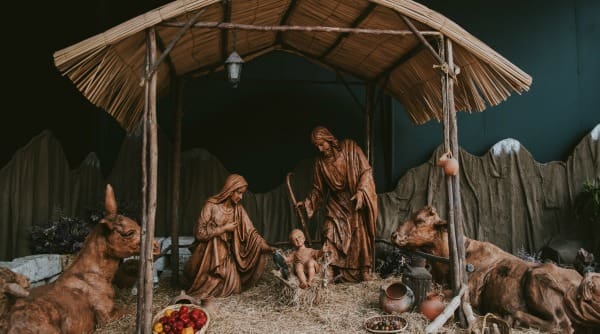Throughout his life, St Francis was consumed by a desire to give his life for Christ. This desire burst into an unquenchable flame when he received news that six of his brothers had been martyred preaching to the Moslems in Morocco. Taking Peter Cattani, Brother Illuminato and several others he set out without delay for the Holy Land to visit the place where Christ was born, lived, preached and then died for us. Would it not be a supreme grace to suffer a martyr’s death where Christ gave his all for us? Francis arrived at Acre early in 1220. His stay was short but eventful. With Brother Illuminato as his companion, he managed to speak before Melek-el-Kamel, the Sultan of Egypt after the siege of Damietta, but St Francis so impressed him that the crown of martyrdom had to be postponed, permanently.
St Francis before the Sultan
When the Sultan asked where they came from, Francis told him they were sent to him by God, so that he could preach the Gospel to his people. Not surprisingly the Sultan was impressed with Francis and invited him to stay with him for a time. It was during his stay that Francis offered to walk into fire with the Sultan’s own priests to prove whose faith was the more authentic, but his priests did not seem too keen on the idea, nor did the Sultan when Francis offered to go it alone. What if he succeeded? The Sultan could not possibly become a Christian, no matter what miracles Francis performed, for he knew very well that to embrace the religion of his enemies was to sign his own death warrant. Francis refused the gifts that were offered to him, but it is generally believed that safe passage to visit the Holy Land was one that he accepted.
From Bethlehem to Greccio
It is believed that he was so moved by what he saw at Bethlehem that on his return to Italy he had an idea which was to stain the memories and the imaginations of everyone with the mystery of the Incarnation. As Christmas drew near he approached John Vellita who owned land in the vicinity of Greccio and asked him for permission to use a cave on his property to re-enact the birth of Brother Jesus at Bethlehem. There were an ass and an ox in the cave and a manger with a statue of the Christ-child lying in the straw. Francis was the deacon at the Mass and spoke with such love and tenderness that many believed that the statue came alive as he cradled it in his arms. Whether this was true or not one thing was for sure, Francis had brought back to life the humanity of Jesus Christ in the minds and in the imaginations of his contemporaries. This achievement was graphically symbolized by this event that took place in Greccio in the Christmas of 1224 and in its aftermath. Henceforth the practice of making cribs at Christmas spread all over the world and all down the centuries to the present day, to remind all, of the world-shaking truth that is at the heart of Franciscan Spirituality.
The meaning of the Immaculate Conception
When you gaze upon the crib each Christmas you are not just looking at a world-shaking event that happened in Bethlehem two thousand years ago, you are looking at the flesh and blood embodiment of an idea conceived in the mind of God from all eternity, to share the ecstatic bliss in which he lived with others. To the understandable question why, oh why should God want to do this, I can only answer by telling you a story.
When I was studying in London in the fifties I stood for hours to get a ticket to see Maria Callas singing at Covent Garden. She was then in her prime and everyone was talking about her stunning performance as Norma. By chance, I managed to get a seat in the front row. The whole experience was the closest thing that I ever experienced to heaven on earth. But would you believe it, I still wasn’t totally happy. I felt that I would only be fully happy if I could share my happiness with others who I loved. I wanted my mother and father to be with me, my brothers and my dearest friends, only then would my cup be overflowing.
Only love impelled God to create us.
Just as I would love to have shared my little human ecstasy with others, God must have loved to share his divine ecstasy with others too. That is what the great Franciscan Theologian Blessed John Duns Scotus meant when he said that love and only love impelled God to create us. To do this he would create a world for them of matter and form, of land and sea, of flora and fauna, of men and women. They would all be created within his other self, his only Son. In this way, he could love them all. Then he would crown this new creation with his presence within it, through his own Son who would be born into this world and rule over it as Christ the King. But a son needs a mother, and the Son of God would need a mother too, not just any mother, but an immaculate mother. This would be necessary to guarantee his growth into his spiritual kingship without being in any way hindered by the sins and weaknesses that inevitably infect even the best of mothers, who despite their best intentions, are passed on to her children by nature and nurture. That is why Mary, the immaculate mother of Jesus, is an essential part of God’s plan that must have been conceived from all eternity.
Scotus and the Immaculate Conception
Scotus argued that the very moment God freely decided that the Word would be made flesh, that very decision included a human mother. How else would he be made flesh? As Scotus put it – “If God wills an end he must will the means”. She would be totally free from the sin contracted later by human sin. When sin did eventually stain humankind God made sure that the human mother of his human Son remained exactly as he had originally conceived her, otherwise his plan would be in jeopardy. It was inconceivable for a woman warped by sin and selfishness to give birth to and bring up a perfect man destined to be the King that he claimed to be before Pilot.
It was for these reasons amongst others, that at the beginning of the fourteenth century Scotus was the greatest champion of the Immaculate Conception. To a modern Catholic this might seem surprising but in those days only a comparatively few believed in the Immaculate Conception as we do. When he preached this doctrine, Scotus was in the minority, sometimes of one as he defended this doctrine against all comers most particularly against the Thomists.
Sister Bernadette and the Immaculate Conception
The Thomists argued that all the descendants of Adam were infected by his sin and that included Mary. Many bitter battles were fought over this doctrine until it was finally defined ‘de fide’ by the Church in 1854. Four years later Our Lady herself confirmed the truth that theologians had argued about for centuries to a young peasant girl who would later be known as St Bernadette. Bernadette did not understand what Our Lady was saying to her, and had to repeat these strange words to herself over and over in her Gascon dialect – “Que soi era Immaculada Concepcion,” all the way back to the parish priest, Fr. Dominique Peyramale, for fear of forgetting them! Only later was the meaning explained to her, and she realized that her ‘Lady’ was indeed The Virgin Mary, Mother of God.
Sister St. Catherine Labouré and the Immaculate Conception
However, it is often forgotten that Our Lady also announced her Immaculate Conception to Sister St. Catherine Labouré during the apparitions at the Rue du Bac in Paris in 1830. I was privileged to see the incorrupt bodies of both these saints, Sister Bernadette at Nevers and Sister St. Catherine Labouré only last year while visiting France. Both these incorrupt bodies testify to the Immaculate Conception. It was Our Lady herself, who taught Sister Catherine the following prayer:
“O Mary conceived without sin, pray for us who have recourse to Thee.”
Our Lady gave Sister Catherine the miraculous medal, first called ‘the medal of Mary of The Immaculate Conception’, and was told to spread the devotion. You might not all be able to see these incorrupt bodies for yourselves, but as we gaze upon the Crib each Christmas we will always be reminded of God’s plan for us, of Mary’s Immaculate Conception and the ecstatic and eternal loving that awaits us with her and her Son Jesus, in the heaven that God has prepared for us since the beginning of time.
If you would like to read more about these themes over Christmas, they are contained in Wisdom from Franciscan Italy. This book has been acclaimed as the best, most readable and most accurate book ever written about St Francis and Franciscan Spirituality. No reviews have ever given it less than five stars.





